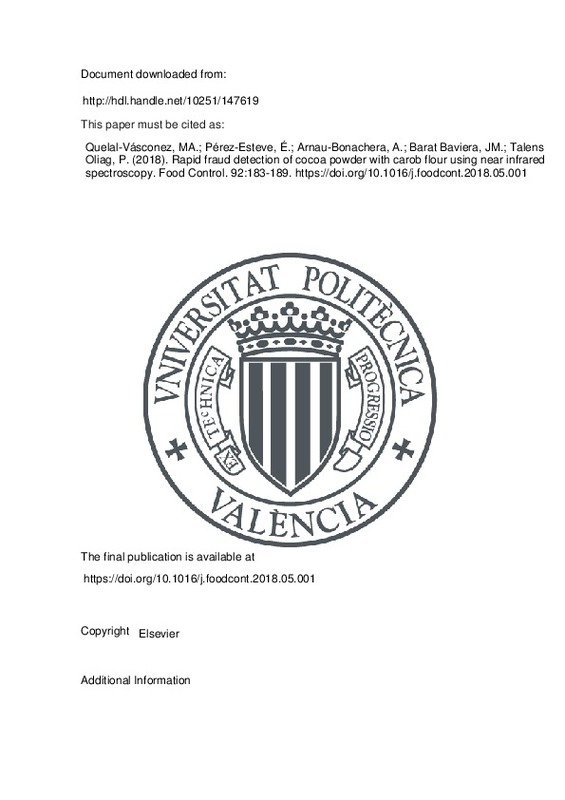JavaScript is disabled for your browser. Some features of this site may not work without it.
Buscar en RiuNet
Listar
Mi cuenta
Estadísticas
Ayuda RiuNet
Admin. UPV
Rapid fraud detection of cocoa powder with carob flour using near infrared spectroscopy
Mostrar el registro sencillo del ítem
Ficheros en el ítem
| dc.contributor.author | Quelal-Vásconez, Maribel Alexandra
|
es_ES |
| dc.contributor.author | Pérez-Esteve, Édgar
|
es_ES |
| dc.contributor.author | Arnau-Bonachera, Alberto
|
es_ES |
| dc.contributor.author | Barat Baviera, José Manuel
|
es_ES |
| dc.contributor.author | Talens Oliag, Pau
|
es_ES |
| dc.date.accessioned | 2020-07-08T03:31:59Z | |
| dc.date.available | 2020-07-08T03:31:59Z | |
| dc.date.issued | 2018-10 | es_ES |
| dc.identifier.issn | 0956-7135 | es_ES |
| dc.identifier.uri | http://hdl.handle.net/10251/147619 | |
| dc.description.abstract | [EN] Cocoa powder is a highly valuable global product that can be adulterated with low-cost raw materials like carob flour as small amounts of this flour would not change the color, aroma and taste characteristics of the final product. Rapid methods, like NIR technology combined with multivariate analysis, are interesting for such detection. In this work, unaltered cocoa powders with different alkalization levels, carob flours with three different roasting degrees, and adulterated samples, prepared by blending cocoa powders with carob flour at several proportions, were analyzed. The diffuse reflectance spectra of the samples of 1100¿2500¿nm were acquired in a Foss NIR spectrophotometer. A qualitative and a quantitative analysis were done. For the qualitative analysis, a principal component analysis (PCA) and a partial least squares discriminant analysis (PLS-DA) were performed. Good results (100% classification accuracy) were obtained, which indicates the possibility of distinguishing pure cocoa powders from adulterated samples. For the quantitative analysis, a partial least squares (PLS) regression analysis was performed. The most robust PLS prediction model was obtained with one factor (LV), a coefficient of determination for prediction (RP2) of 0.974 and a root mean square error of prediction (RMSEP) of 3.2% for the external set. These data allowed us to conclude that NIR technology combined with multivariate analysis enables the identification and determination of the amount of natural cocoa powder present in a mixture adulterated with carob flour. | es_ES |
| dc.description.sponsorship | The authors wish to acknowledge the financial assistance provided by the Spanish Government and European Regional Development Fund (Project RTC-2016-5241-2). Maribel Quelal Vásconez thanks the Ministry of Higher Education, Science, Technology and Innovation (SENESCYT) of the Republic of Ecuador for her PhD grant. The Olam Food Ingredients Company is acknowledged for proving part of the cocoa samples used herein | es_ES |
| dc.language | Inglés | es_ES |
| dc.publisher | Elsevier | es_ES |
| dc.relation.ispartof | Food Control | es_ES |
| dc.rights | Reserva de todos los derechos | es_ES |
| dc.subject | Cocoa powder | es_ES |
| dc.subject | Adulteration | es_ES |
| dc.subject | Carob flour | es_ES |
| dc.subject | NIR | es_ES |
| dc.subject | PCA | es_ES |
| dc.subject | PLS | es_ES |
| dc.subject.classification | TECNOLOGIA DE ALIMENTOS | es_ES |
| dc.subject.classification | PRODUCCION ANIMAL | es_ES |
| dc.title | Rapid fraud detection of cocoa powder with carob flour using near infrared spectroscopy | es_ES |
| dc.type | Artículo | es_ES |
| dc.identifier.doi | 10.1016/j.foodcont.2018.05.001 | es_ES |
| dc.relation.projectID | info:eu-repo/grantAgreement/MINECO//RTC-2016-5241-2/ES/Estudio de la relación entre variables de procesado y cambios en la composición nutricional y perfil funcional del cacao en polvo. Desarrollo de una metodología predictiva aplicada al procesamiento/ | es_ES |
| dc.rights.accessRights | Abierto | es_ES |
| dc.contributor.affiliation | Universitat Politècnica de València. Departamento de Ciencia Animal - Departament de Ciència Animal | es_ES |
| dc.contributor.affiliation | Universitat Politècnica de València. Departamento de Tecnología de Alimentos - Departament de Tecnologia d'Aliments | es_ES |
| dc.description.bibliographicCitation | Quelal-Vásconez, MA.; Pérez-Esteve, É.; Arnau-Bonachera, A.; Barat Baviera, JM.; Talens Oliag, P. (2018). Rapid fraud detection of cocoa powder with carob flour using near infrared spectroscopy. Food Control. 92:183-189. https://doi.org/10.1016/j.foodcont.2018.05.001 | es_ES |
| dc.description.accrualMethod | S | es_ES |
| dc.relation.publisherversion | https://doi.org/10.1016/j.foodcont.2018.05.001 | es_ES |
| dc.description.upvformatpinicio | 183 | es_ES |
| dc.description.upvformatpfin | 189 | es_ES |
| dc.type.version | info:eu-repo/semantics/publishedVersion | es_ES |
| dc.description.volume | 92 | es_ES |
| dc.relation.pasarela | S\362139 | es_ES |
| dc.contributor.funder | Secretaría de Educación Superior, Ciencia, Tecnología e Innovación, Ecuador | es_ES |
| dc.contributor.funder | Ministerio de Economía y Competitividad | es_ES |







![[Cerrado]](/themes/UPV/images/candado.png)

